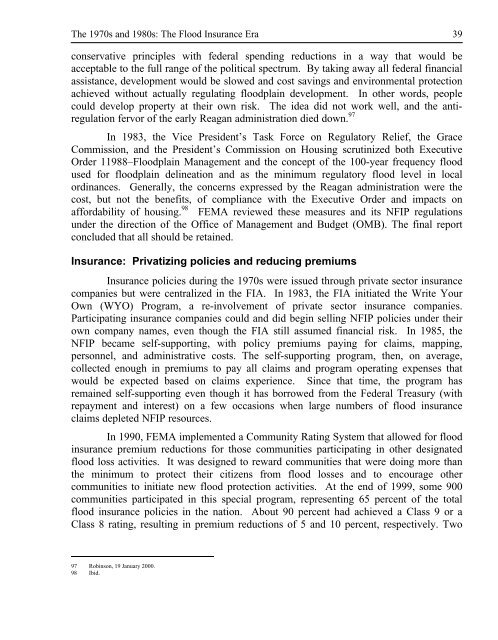The Nation's Responses To Flood Disasters: A Historical Account
The Nation's Responses To Flood Disasters: A Historical Account
The Nation's Responses To Flood Disasters: A Historical Account
You also want an ePaper? Increase the reach of your titles
YUMPU automatically turns print PDFs into web optimized ePapers that Google loves.
<strong>The</strong> 1970s and 1980s: <strong>The</strong> <strong>Flood</strong> Insurance Era 39<br />
conservative principles with federal spending reductions in a way that would be<br />
acceptable to the full range of the political spectrum. By taking away all federal financial<br />
assistance, development would be slowed and cost savings and environmental protection<br />
achieved without actually regulating floodplain development. In other words, people<br />
could develop property at their own risk. <strong>The</strong> idea did not work well, and the antiregulation<br />
fervor of the early Reagan administration died down. 97<br />
In 1983, the Vice President’s Task Force on Regulatory Relief, the Grace<br />
Commission, and the President’s Commission on Housing scrutinized both Executive<br />
Order 11988–<strong>Flood</strong>plain Management and the concept of the 100-year frequency flood<br />
used for floodplain delineation and as the minimum regulatory flood level in local<br />
ordinances. Generally, the concerns expressed by the Reagan administration were the<br />
cost, but not the benefits, of compliance with the Executive Order and impacts on<br />
affordability of housing. 98 FEMA reviewed these measures and its NFIP regulations<br />
under the direction of the Office of Management and Budget (OMB). <strong>The</strong> final report<br />
concluded that all should be retained.<br />
Insurance: Privatizing policies and reducing premiums<br />
Insurance policies during the 1970s were issued through private sector insurance<br />
companies but were centralized in the FIA. In 1983, the FIA initiated the Write Your<br />
Own (WYO) Program, a re-involvement of private sector insurance companies.<br />
Participating insurance companies could and did begin selling NFIP policies under their<br />
own company names, even though the FIA still assumed financial risk. In 1985, the<br />
NFIP became self-supporting, with policy premiums paying for claims, mapping,<br />
personnel, and administrative costs. <strong>The</strong> self-supporting program, then, on average,<br />
collected enough in premiums to pay all claims and program operating expenses that<br />
would be expected based on claims experience. Since that time, the program has<br />
remained self-supporting even though it has borrowed from the Federal Treasury (with<br />
repayment and interest) on a few occasions when large numbers of flood insurance<br />
claims depleted NFIP resources.<br />
In 1990, FEMA implemented a Community Rating System that allowed for flood<br />
insurance premium reductions for those communities participating in other designated<br />
flood loss activities. It was designed to reward communities that were doing more than<br />
the minimum to protect their citizens from flood losses and to encourage other<br />
communities to initiate new flood protection activities. At the end of 1999, some 900<br />
communities participated in this special program, representing 65 percent of the total<br />
flood insurance policies in the nation. About 90 percent had achieved a Class 9 or a<br />
Class 8 rating, resulting in premium reductions of 5 and 10 percent, respectively. Two<br />
97 Robinson, 19 January 2000.<br />
98 Ibid.
















